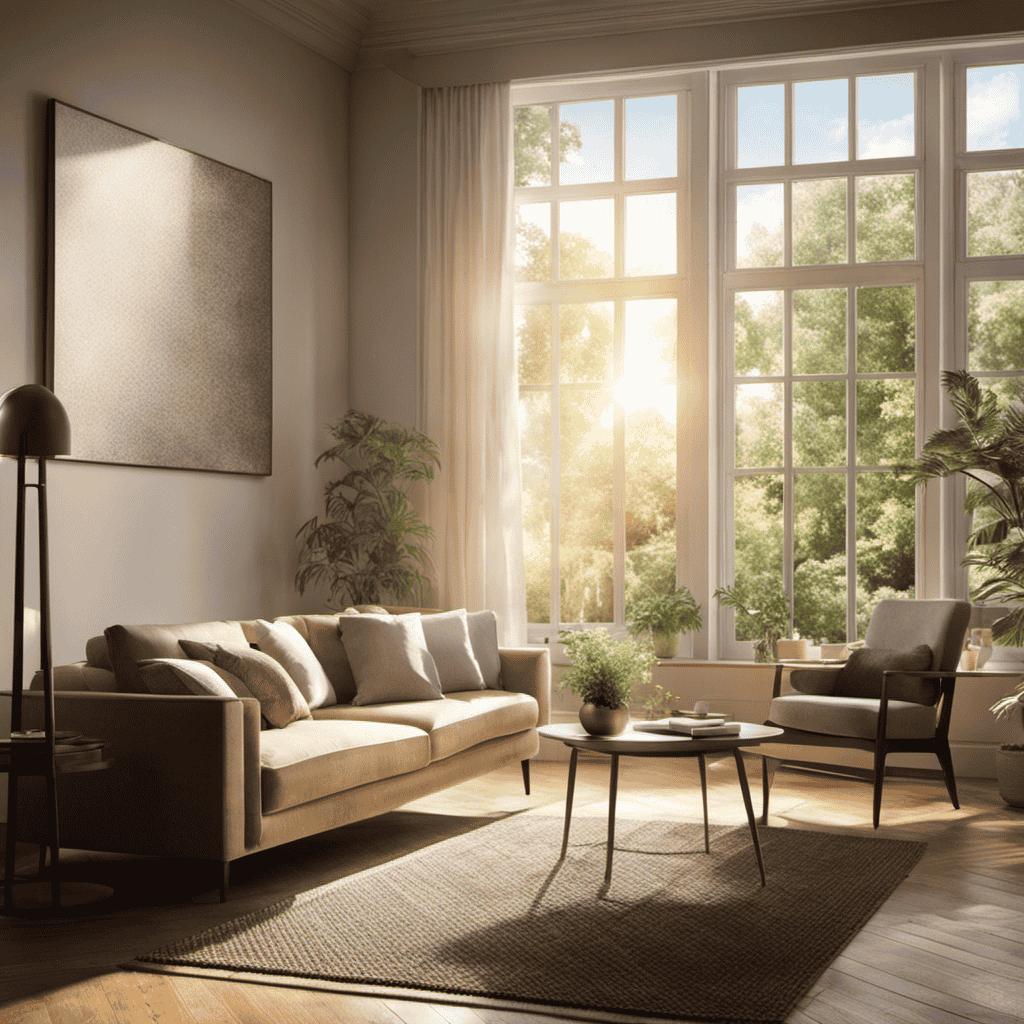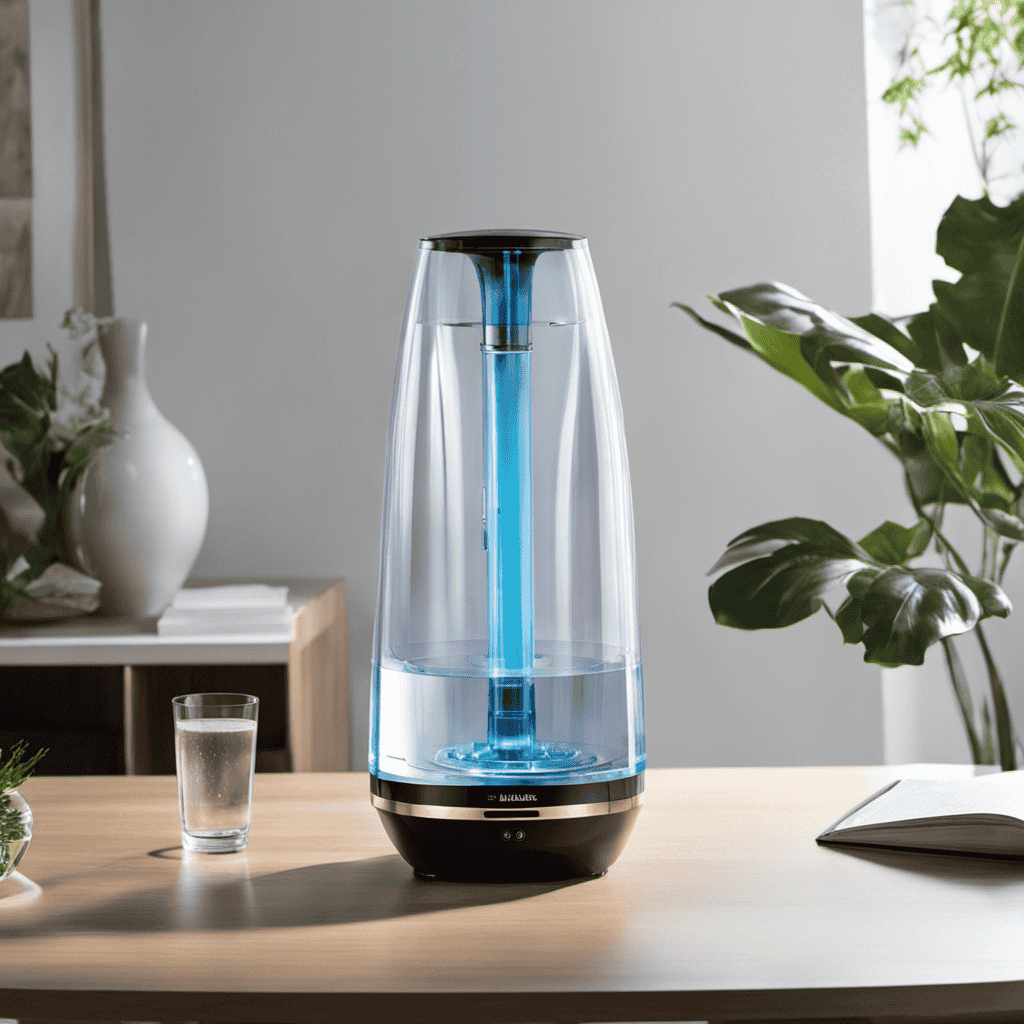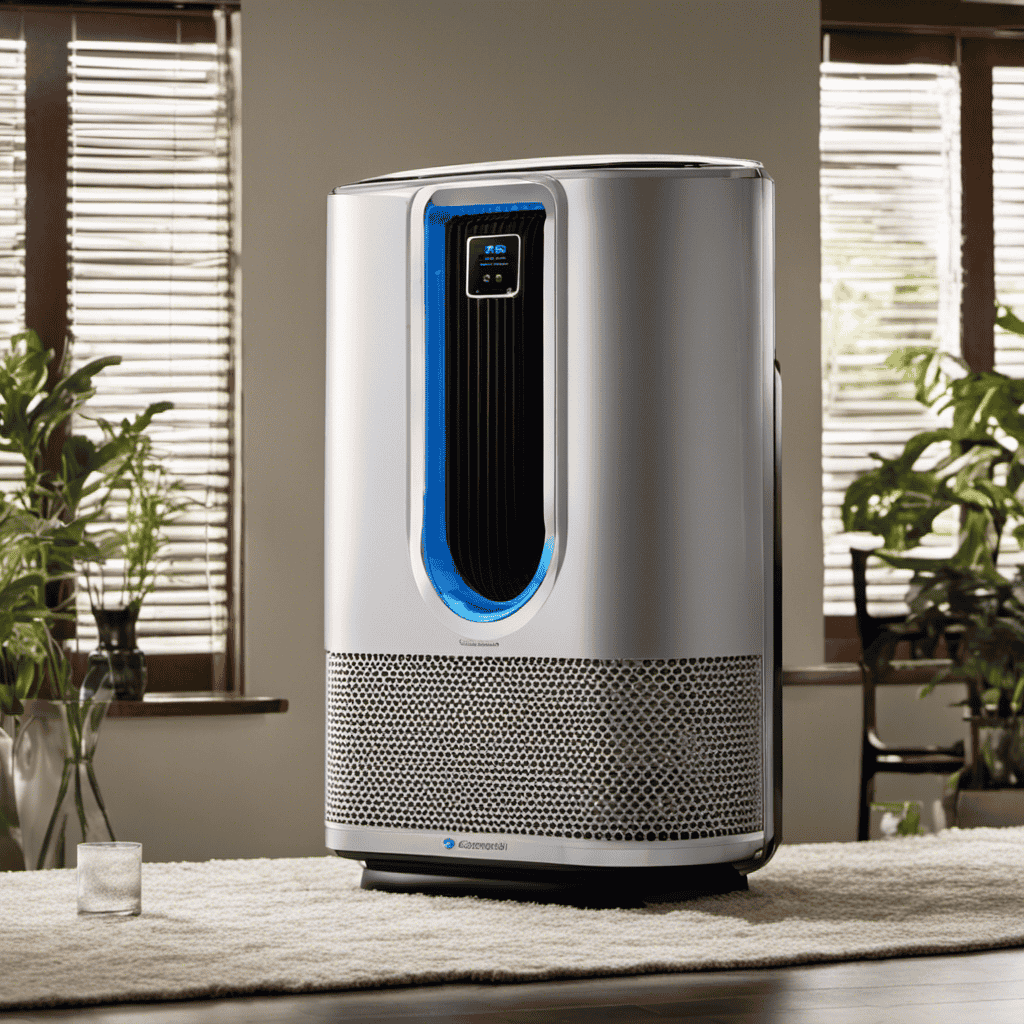I have always been curious about the optimal time to activate my air purifier. Upon conducting some research, I found out that utilizing an air purifier can offer various advantages, including decreasing allergens and enhancing the quality of indoor air.
But how do you know when it’s necessary to turn it on? In this article, we will explore the common triggers for using an air purifier, signs of poor indoor air quality, and factors to consider when deciding to turn on your air purifier.
Let’s dive in and optimize the effectiveness of our air purifiers together.
Key Takeaways
- High levels of pollutants like dust, pollen, and pet dander are indicators for turning on an air purifier.
- Noticeable odors or a stuffy feeling in the air can be a sign that it’s time to use an air purifier.
- Seasonal allergy triggers, such as increased pollen counts or the presence of mold spores, indicate the need for an air purifier.
- Using an air purifier during sleep, after cleaning, or during maintenance tasks can help maintain indoor air quality and reduce exposure to allergens.
Benefits of Using an Air Purifier
You’ll love the benefits of using an air purifier in your home. Air purifiers offer numerous advantages when it comes to improving indoor air quality.
Firstly, they effectively remove harmful airborne particles such as dust, pollen, pet dander, and mold spores, reducing the risk of respiratory issues and allergies.
Additionally, air purifiers can eliminate unpleasant odors caused by cooking, pets, or smoke, making your home smell fresher and cleaner.
Moreover, air purifiers can help to reduce the concentration of volatile organic compounds (VOCs) in the air, which are released by certain household products and can have adverse health effects.
Furthermore, air purifiers can trap and neutralize bacteria and viruses, promoting a healthier environment.
Overall, investing in an air purifier can greatly enhance the air quality in your home and improve your overall well-being.
Common Triggers for Using an Air Purifier
One common trigger for using an air purifier is when there’s a high pollen count in the environment. Pollen is a common allergen that can cause symptoms like sneezing, coughing, and itchy eyes. An air purifier can help remove pollen from the air, reducing the risk of allergic reactions.
In addition to pollen, air purifiers can also be useful in removing other airborne particles such as dust, pet dander, and mold spores.
To ensure the optimal performance of an air purifier, regular maintenance is essential. This includes cleaning or replacing the filters as recommended by the manufacturer.
When choosing an air purifier, it’s important to consider the size of the room, the specific pollutants you want to target, and the noise level of the device.
Signs of Poor Indoor Air Quality
If you’re experiencing symptoms like coughing, sneezing, or headaches, it could be a sign of poor indoor air quality. Indoor air pollution can come from various sources, such as cooking, cleaning products, tobacco smoke, pet dander, and even building materials.
These pollutants can have detrimental effects on our health. For instance, exposure to indoor air pollution can worsen respiratory conditions like asthma and allergies. It may also lead to respiratory infections and respiratory tract irritation. Long-term exposure to poor indoor air quality has been associated with an increased risk of cardiovascular diseases, lung cancer, and even premature death.
To improve indoor air quality, it is important to minimize the use of pollutants, ensure proper ventilation, and consider using air purifiers to filter out harmful particles and improve the overall air quality in your home or workplace.
How to Determine When to Turn on Your Air Purifier
When it comes to monitoring air quality, there are several indicators that can help determine if it’s time to turn on your air purifier. These indicators include high levels of pollutants such as dust, pollen, and pet dander. Noticeable odors or a stuffy feeling in the air are also important factors to consider.
Additionally, seasonal allergy triggers, such as increased pollen counts or the presence of mold spores, can also be important factors to consider.
Air Quality Indicators
The air quality indicators can help you determine when to turn on the air purifier. Monitoring the air quality is essential to ensure that the air you breathe indoors is clean and healthy.
Here are four key indicators to consider when deciding to use your air purifier:
-
Particulate Matter (PM): High levels of PM, such as dust, pollen, and pet dander, can trigger allergies and respiratory issues.
-
Volatile Organic Compounds (VOCs): These harmful chemicals can be released from cleaning products, paints, and furniture, affecting indoor air quality.
-
Carbon Dioxide (CO2): Elevated CO2 levels indicate poor ventilation, which can lead to stuffy air and fatigue.
-
Air Quality Index (AQI): This index measures overall air quality, taking into account various pollutants.
By monitoring these indicators, you can adjust your air purifier settings accordingly and ensure that it is running when needed.
Now, let’s explore the next section about seasonal allergy triggers.
Seasonal Allergy Triggers
To alleviate your seasonal allergies, it’s important to identify common triggers and take preventive measures.
One of the most common triggers for seasonal allergies is pollen. Pollen levels can vary depending on the time of year and the region you live in. When pollen levels are high, it’s more likely for allergy symptoms to flare up. These symptoms can include sneezing, itchy eyes, runny nose, and congestion.
To reduce your exposure to pollen, it’s recommended to keep windows closed, use air conditioning with proper filtration, and avoid spending extended periods of time outside when pollen counts are high. Additionally, regularly cleaning your home, especially carpets and bedding, can help remove any pollen that may have been brought indoors.
Taking these preventive measures can significantly reduce your allergy symptoms and improve your overall well-being.
Best Times to Use an Air Purifier
Using an air purifier during allergy season can help improve indoor air quality. As someone who suffers from seasonal allergies, I have found that using an air purifier at specific times can make a significant difference in reducing my symptoms.
Here are the best times to use an air purifier:
-
Allergen-heavy days: On days when pollen or other allergens are particularly high, running the air purifier can help filter out these irritants and provide relief.
-
During sleep: Running the air purifier in your bedroom while you sleep can help create a clean and allergen-free environment, allowing for a better night’s rest.
-
After cleaning: When you clean your home, dust and other particles can get stirred up into the air. Running the air purifier afterwards can help capture these particles and maintain clean indoor air.
-
During air purifier maintenance: Regular maintenance is crucial for optimal performance. During maintenance tasks such as filter replacements or cleaning, it’s recommended to turn on the air purifier to prevent any potential contaminants from spreading.
Considering these factors, it’s important to find a cost-effective air purifier that suits your needs and performs well in maintaining indoor air quality. By following these guidelines, you can maximize the benefits of using an air purifier and improve your overall respiratory health.
Now, let’s explore the factors to consider when deciding to turn on your air purifier.
Factors to Consider When Deciding to Turn on Your Air Purifier
If you’re unsure whether or not to run your air purifier, consider the factors that can affect indoor air quality.
When deciding to turn on your air purifier, it’s important to keep up with regular maintenance to ensure its effectiveness. Filters should be cleaned or replaced according to the manufacturer’s instructions, as dirty filters can hinder the purifier’s ability to capture airborne particles.
Additionally, consider the energy consumption of your air purifier. Some models may consume more energy than others, so it’s essential to choose an energy-efficient option.
Running your air purifier continuously may not be necessary, as it can be more cost-effective to use it during peak pollution hours or when you notice a decline in indoor air quality.
How to Optimize the Effectiveness of Your Air Purifier
When it comes to optimizing the effectiveness of your air purifier, there are several key points to consider.
First, you need to determine the filter replacement frequency based on the manufacturer’s recommendations and the air quality in your area.
Secondly, proper placement considerations are crucial to ensure that the air purifier can efficiently capture pollutants and distribute clean air throughout the room.
Lastly, room size compatibility is an important factor to take into account, as the air purifier should be able to effectively clean the air in the given space.
Filter Replacement Frequency
To ensure optimal performance, you should regularly check and replace the filters in your air purifier. Proper maintenance of your air purifier is crucial in order to maintain clean and healthy air in your home. Here are some important tips for filter replacement and air purifier maintenance:
-
Follow the manufacturer’s recommended filter replacement schedule. Different types of filters have different lifespans, so it’s important to know when to replace them.
-
Check the filters regularly for any signs of dirt, dust, or discoloration. If you notice a significant buildup of particles, it’s time to replace the filter.
-
Keep track of the air quality in your home. If you notice an increase in allergens or odors, it may be a sign that the filters need to be replaced.
-
Clean the exterior of the air purifier regularly to remove any dust or debris that may have accumulated.
Proper Placement Considerations
The location of your air purifier is important for optimal performance and clean air in your home. When considering the placement of your air purifier, it is crucial to take into account factors such as air purifier noise levels and energy consumption.
To minimize noise levels, it is recommended to place the air purifier in a location where it can operate without obstruction. Avoid placing it near walls or furniture that may reflect or amplify the noise.
Additionally, consider the energy consumption of the air purifier. Placing it in a central location within the room can help distribute the purified air more efficiently, reducing the need for the air purifier to work harder and consume more energy.
Room Size Compatibility
Consider the size of your room to determine if the air purifier is compatible. Room size compatibility is an important factor to consider when purchasing an air purifier. Here are some key points to keep in mind:
-
Measure the square footage of your room: Air purifiers are designed to clean a specific area. Make sure the purifier you choose is suitable for the size of your room.
-
Check the Clean Air Delivery Rate (CADR): This rating indicates the purifier’s effectiveness in removing pollutants from the air. Ensure that the CADR matches or exceeds the recommended value for your room size.
-
Noise level considerations: Some air purifiers can be noisy, which can be disruptive in smaller rooms or during sleep. Look for models with a noise level that is acceptable for your needs.
-
Consider the placement: Ensure that the purifier has enough space to circulate clean air effectively and that it does not obstruct any furniture or walkways.
How Long to Run Your Air Purifier Each Day
You should determine how long you need to run your air purifier each day for optimal air quality. The duration depends on various factors such as the size of your room, the level of air pollution, and the capacity of your air purifier. To help you understand better, I have prepared a table outlining the recommended running time for different room sizes.
| Room Size | Recommended Running Time |
|---|---|
| Small | 4-6 hours |
| Medium | 8-10 hours |
| Large | 12-16 hours |
| Extra Large | 16-24 hours |
| Open Concept | 24/7 |
It’s important to note that running your air purifier continuously can result in higher energy consumption. Therefore, if you have a smaller room or the air quality is not severely compromised, you can adjust the running time accordingly to save energy.
Additional Tips for Maintaining Clean Air in Your Home
For better air quality in your home, try keeping your windows open for a few minutes each day. This allows fresh air to circulate and helps reduce indoor pollutants.
In addition to this simple step, here are some effective cleaning techniques to further improve the air quality in your home:
-
Dust and vacuum regularly: Dust and allergens can accumulate on surfaces and in carpets, so it’s important to dust and vacuum frequently to remove these pollutants.
-
Use natural cleaning products: Many conventional cleaning products contain harsh chemicals that can contribute to indoor air pollution. Opt for natural alternatives to reduce exposure to these chemicals.
-
Keep humidity levels in check: High humidity can promote the growth of mold and mildew, which can worsen indoor air quality. Use a dehumidifier to maintain optimal humidity levels.
-
Avoid smoking indoors: Smoking releases harmful chemicals and pollutants into the air. Make your home a smoke-free environment to protect your indoor air quality.
– What Are the Benefits of Running an Air Purifier?
Running an air purifier in your home can have significant benefits. Air purifiers can improve indoor air quality by removing contaminants such as dust, pollen, pet dander, and smoke. This can lead to better respiratory health, reduced allergy symptoms, and a cleaner living environment. Discover the benefits of air purifiers today.
Frequently Asked Questions
Can I Leave My Air Purifier on All the Time?
Yes, I can leave my air purifier on all the time, but it may increase the cost of running it and the energy consumption. It’s important to consider the benefits and drawbacks before making a decision.
Do Air Purifiers Help With Allergies?
Air purifiers can help with allergies by removing allergens like pollen and dust particles from the air. They can also improve respiratory health and help manage asthma symptoms by reducing indoor air pollution.
Are Air Purifiers Loud?
When I first turned on my air purifier, I was worried about the noise level. However, I was pleasantly surprised by how quiet it was. The air purifier’s sound volume was barely noticeable, allowing me to sleep peacefully at night.
How Often Should I Change the Filters in My Air Purifier?
When to replace air purifier filters and how to clean them depends on the specific model and usage. Regularly checking and following the manufacturer’s recommendations ensures optimal performance and air quality.
Can an Air Purifier Remove Pet Odors From My Home?
An air purifier can effectively remove pet odors from your home, thanks to its ability to filter out airborne contaminants and particles. Using an air purifier regularly can provide numerous benefits for maintaining clean and fresh air indoors.
Conclusion
In conclusion, it is clear that maintaining clean air in our homes is of utmost importance. By understanding the signs of poor indoor air quality and considering factors such as pollutants and allergies, we can determine when to turn on our air purifiers. Additionally, optimizing the effectiveness of our purifiers and running them for an appropriate duration each day will ensure that we breathe in fresh and healthy air.
As the saying goes, ‘Clean air is a breath of fresh air,’ and with the right knowledge and actions, we can achieve just that.










